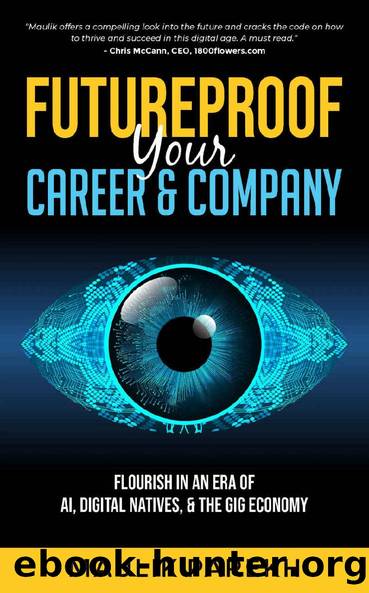Futureproof Your Career and Company: Flourish in an Era of AI, Digital Natives, and The Gig Economy by Maulik Parekh

Author:Maulik Parekh [Parekh, Maulik]
Language: eng
Format: epub
Publisher: Maulik Parekh
Published: 2020-11-14T00:00:00+00:00
CHAPTER 9
THE FUTURE IS DIGITAL: TRANSFORM BUSINESS
âCitizens are speaking to their governments using 21st century technologies, governments are listening on 20th century technology and providing 19th century solutions.â
Madeleine Albright, US Secretary of State
âIt was big and clunky,â you might say. âAbout the size of a toaster.â
It weighed 8 pounds and required 16 AA batteries. It took 23 seconds to take and store a black and white photograph with a resolution of 0.01MP. It was the worldâs first portable digital camera, and only one person saw its potential.1
The year was 1975. A 24-year-old engineer turned inventor named Steven Sasson excitedly shared the news about his latest invention. His bosses at Eastman Kodak were unimpressed.
According to Sasson, their reaction was, âPrint had been with us for over 100 years, no one was complaining about the prints, they were very inexpensive, and so why would anyone want to look at their picture on a television set?â2
Kodak filed for bankruptcy in 2012.3
Secretary Albright was referring to the public sector when she raised the alarm about the dire need for digital transformation. If she was also referring to the private sector, she would have been spot-on.
Why digital transformation?
We covered three disruptive forces in the first section of the book: AI, digital generations, and the gig economy.
As these swelling forces gain momentum over the next decade, they have the potential to significantly disrupt the ecosystem you operate in. They have the potential to radically change what customers and employees expect of you. And hence, if you donât transform, they have the potential to render your very business model obsolete.
While, out of habit, you may be busy training your guns on an age-old rival in your industry, these forces furnish a fertile ground for a disruptor (like Amazon for retail, Airbnb for hospitality, and Uber for transportation) to sprout out of nowhere to out-wit, out-think, and outmaneuver you and eat your lunch forever.
Speaking of lunch, take Dominoâs Pizza as an example.
During the last decade, the company has taken a big slice of market share from its competitors â Pizza Hut and Papa Johnâs.
How did the 60-year company pull this off?
By reinventing itself as a young and feisty disruptor.
Just 12 years ago, Dominoâs Pizza was struggling in the marketplace. Sales and the stock price were falling. Customers complained the crust tasted like cardboard and the pizza sauce tasted like ketchup.4
So, it revamped its recipe. It created a richer, spicier sauce, tastier cheese combination, and a buttery crust with garlic and herbs.
Revamping the recipe was a no-brainer.
But Dominoâs brilliantly revamped one more thing.
The companyâs business model.
It aspired to become an eCommerce company that sells pizza. It crafted, invested in, and implemented an ambitious digital transformation strategy.
Remember the days when you could order Dominoâs Pizza only two ways â by walking into a restaurant or by calling?
Today, Dominoâs offers 15 different ways to order pizza.5
You can simply go to an app and order the pizza.
You donât like clicking through the app. No problem. There is a Zero Click option.
You like emojis more than words.
Download
This site does not store any files on its server. We only index and link to content provided by other sites. Please contact the content providers to delete copyright contents if any and email us, we'll remove relevant links or contents immediately.
Storytelling for dummies by Andrea Fontana(1494)
Effortless by Greg McKeown(1434)
The Practice by Seth Godin(1406)
Mastering Blockchain by Lorne Lantz(1394)
Blockchain Quick Reference by Paul Valencourt & Samanyu Chopra & Brenn Hill(1152)
Mastering Blockchain by Lorne Lantz & Daniel Cawrey(909)
The wind in the willows by Kenneth Grahame(853)
How to Lead by David M. Rubenstein(826)
The Ape in the Corner Office by Richard Conniff(792)
Handbook of Big Data Analytics by Unknown(713)
Social Media Engagement For Dummies by Aliza Sherman(711)
Taking Care of Yourself (HBR Working Parents Series) by Harvard Business Review(698)
Getting Started with Data: The first book you should read to successfully get along with data. by Menegatti Gabriel & Team Simbiose Ventures(695)
FunRetrospectives: activities and ideas for making agile retrospectives more engaging by Paulo Caroli & Tainã Caetano Coimbra(693)
Business Storytelling For Dummies by Unknown(670)
Evernote for Self Publishing: How to Write Your Book in Evernote from Start to Finish by Jose John(669)
Help! My Facebook Ads Suck-- by M. D. Cooper & Jill Cooper(654)
A Leader Listens by Ajay Banga(640)
Genius by Choice: Your unconventional A–Z handbook to enhance your learning process by Remondino Giulia S(640)
